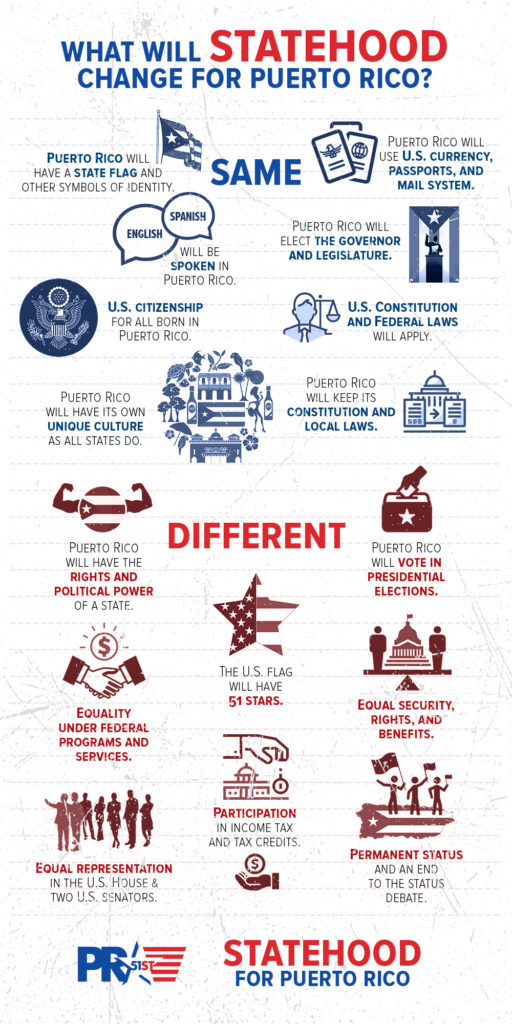One claim we see from anti-statehood factions is that Puerto Rico voters, when they voted for statehood three times this century, didn’t really know what they were voting for. This claim is usually followed by a demand that Congress make it clear what statehood would mean for Puerto Rico.
There’s really no mystery here. We have 50 states. Under the U.S. Constitution, all states are on an equal footing. Small states like Rhode Island and Wyoming are just as important, and have just as many senators, as big states like Texas and California. States in the west get the same treatment in federal programs as states in the east. We can look at current states and see what statehood will be like for Puerto Rico.
However, the Government Accountability Office prepared a report in 2014 that predicted some specific economic changes under statehood. Most of the figures were based on 2010 spending, the most recent data available at that time. The GAO concluded that 11 federal programs would be different for the state of Puerto Rico than for the territory of Puerto Rico.
Programs that would be affected
The four largest and most important programs for which the GAO expected a change are these:
- Medicare: in 2010, federal spending for Medicare in Puerto Rico was $4.5 billion; as a state, Puerto Rico would have received $4.5 to $6 billion.
- Medicaid: spending was $685 million; had Puerto Rico been a state, it could have been as high as $2.1 billion.
- Supplemental Nutrition Assistance Program (SNAP): NAP spending in 2010 was $1.9 billion; as a state,Puerto Rico could have received $1.7 billion to $2.6 billion. The amount might have been smaller because recipients of SSI (see below) might not have needed food stamps.
- Supplemental Security Income (SSI): Puerto Rico is excluded from SSI benefits, a law which is currently being examined by the Supreme Court. A similar program cost $24 million in 2010. The GAO estimates that SSI coverage would have totaled $1.5 billion to $1.8 billion.
The GAO reported that residents of Puerto Rico paid $20 million in taxes in 2010, mostly to the United States. As a state, Puerto Rico might pay as much as $2.3 billion. The GAO also estimated that corporations might pay an additional $3.4 billion in corporate income tax, although this estimate was more complicated than the estimate for individuals, and less certain. It could be as high as $9.3 billion.
Puerto Rico could expect to have more funding for highways, and for the Children’s Health Insurance Program.
The GAO speculated that eligibility for PEL grants, WIC (Women and Infants), housing assistance, and TANF (Temporary Assistance for Needy Families) might change.
Future possibilities
The figures above suggest that Puerto Rico would receive a lot more federal funds as a state than as a territory. However, that’s not the whole story.
“Statehood could result in dynamic economic and fiscal changes for Puerto Rico, changes that could ultimately impact the level of federal spending in Puerto Rico, and the revenue collected from residents of, and corporations in, Puerto Rico,” the GAO pointed out “However, the precise nature of how such changes would affect federal spending and revenue is uncertain.”
Hawaii’s admission as a state was followed almost immediately by an enormous boom in construction and tourism. Real per capita personal income increased at an annual rate of 4 percent. Investment by companies from the United States and from other nations both jumped. Puerto Rico already has some real advantages in its largely bilingual educated workforce, strong track record in pharmaceuticals and medical devices, and impressive natural beauty. Statehood would level the playing field for Puerto Rico and lead to greater prosperity. The GAO said, “Statehood could eliminate any risk associated with Puerto Rico’s uncertain political status and any related deterrent to business investment.”
This could lead to less dependence on federal funding and greater tax participation by companies and individuals in Puerto Rico, benefiting the United States as a whole economically.
There may be other changes. For example, the number of people leaving Puerto Rico has been extremely high in recent decades, leading to a loss of human capital on the Island. As a state, Puerto Rico would be in a stronger position economically and might see less outmigration. Hawaii’s population grew significantly after its admission as a state. Puerto Rico could see the same change.
Some anti-statehood factions claim that a state of Puerto Rico would lose its language and culture. With more than 5 million Puerto Ricans living in the states and roughly 3.2 million living in Puerto Rico, we can see that Puerto Rican culture is stronger than this claim suggests. The 50 states continue to have and take pride in their own differences from one another as well as their shared American identity. We doubt that Puerto Rico would be different in this respect.
The other changes we can be sure of? Puerto Rico would have two senators, four or more Members in the House, and full participation in presidential elections. With a full voice in American democracy, the Island’s priorities would have the same degree of influence that the current 50 states have.

The ball is now in Congress’s court. Please contact your representatives and encourage them to take their place on the right side of history.








No responses yet